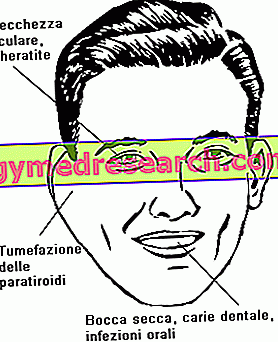Generality
Sjögren's syndrome is an inflammatory disease caused by an anomaly of the immune system. The characteristic symptoms of this autoimmune disease arise at the level of the exocrine glands, in particular those of the eye and the oral cavity; subsequently, other organs and tissues of the organism are also involved.

What is Sjögren's syndrome
Sjögren's syndrome is an inflammatory disease that affects the exocrine glands .
Triggering inflammation are dysfunctions of the immune system . The latter, in fact, causes damage to the organism, instead of defending it, as it normally should do, from pathogenic agents (viruses and bacteria) and other diseases.
Therefore, Sjögren's syndrome is also considered an autoimmune disease .
All exocrine glands are possible targets of the disease, but those most affected are salivary and lacrimal.
Sjögren syndrome, PRIMITIVE FORM
It is the form that appears in isolation, without association with other diseases.
Sjögren syndrome, SECONDARY FORM
This is the form that appears in association with other autoimmune diseases, such as:
- Rheumatoid arthritis
- Systemic lupus erythematosus (SLE)
- Scleroderma
- Primary biliary cirrhosis
- Hashimoto's thyroiditis
- Mixed connectivity
- Systemic vasculitis
Epidemiology
Sjögren's syndrome is a fairly common condition. Several studies report a prevalence value ranging between 0.4 and 0.6% of the population. As for the incidence, instead, it seems that the new cases per year are about 3-6 per 100, 000 inhabitants.
It affects women the most and has no preference for any particular ethnic group. Adult / advanced age is another predisposing factor: most cases occur between the ages of 50 and 70.
This data is partially complete. It has been observed, in fact, that the seventy years, rather than the forty, are more subjected to a meticulous diagnosis.
Epidemiology of Sjögren's syndrome | |
| Sex more affected | Women. The relationship with men is 9: 1 |
| Incidence | 3-6 new cases per year per 100, 000 inhabitants |
| Prevalence | 0.4 - 0.6% of the population, without distinction of ethnicity |
| Age of onset | Most diagnoses concern people between 50 and 70 years old. But cases of 40-45 years are also frequent. |
Causes and pathogenesis
The cause of Sjögren's syndrome is an abnormal behavior of some defensive elements of the immune system. In fact, T lymphocytes, B lymphocytes, antibodies, dendritic and immune complex cells "rebel" and attack the organism, instead of defending it. They are wedged into the exocrine glandular tissue, creating the so-called lymphocytic infiltrate, and they gradually destroy it. Furthermore, the lymphocyte infiltrate also affects some non-glandular (or extra-glandular) areas, damaging them.
But what determines the "revolt" of the immune system?
RISK FACTORS
There is still uncertainty about the true cause of the autoimmune character of the disease. It seems that at the origin there is a combination of two factors:
- genetic
- Viral
The most accepted hypothesis holds that a virus triggers the autoimmune reaction only in a genetically predisposed individual; therefore, the presence of only one of the two components (genetic or viral) would not be sufficient to determine Sjögren's syndrome. There are more accredited viruses than others, such as cytomegalovirus, Epstain-Barr virus, Coxsackie Virus and some retroviruses (HTLV-1 and HVR-5), but certain data do not yet exist.
Symptoms and complications
To learn more: Sjogren's syndrome
The most common symptoms of Sjögren's syndrome occur in the salivary exocrine glands and lacrimal exocrine glands .
The progressive degeneration of the salivary glands determines xerostomia ; that of the lacrimal glands causes xerophthalmia and dry keratoconjunctivitis .
Other affected exocrine glands are located at the level of:
- Skin
- Nose
- Lungs and bronchi
- Vagina
Furthermore, other different parts of the body are involved, not properly formed by glandular tissue. These are areas adjacent to or connected to a target exocrine gland. These disorders occur at an advanced stage of the disease and affect, for example, the gastrointestinal tract, the kidneys or the joints. It will be discussed in detail in the chapter on extraglandular manifestations.
Xerostomia
It is the reduction of saliva secretion . Therefore, the mucous membrane of the mouth is dry. Furthermore, the consistency of the salivary liquid also changes: it becomes viscous, dense and contains less lysozyme . All this results in a difficulty in eating dry foods, in the need to drink frequently (even at night), in a decrease in taste, in the formation of fissures on the tongue or in an impediment to speaking quickly and for long periods of time.
Patients with Sjögren's syndrome are particularly prone to complications, such as dental caries and oral candidiasis . This is due to the fact that type A (IgA) immunoglobulins are contained in the saliva, which play a protective role against oral bacteria.
A complete picture of the consequences due to xerostomia is shown in the table.
| Characteristics of xerostomia | Consequences |
| Reduction of salivary secretion Thick, viscous saliva containing less lysozyme | Difficulty eating dry foods |
| Need to drink frequently | |
| Decrease in taste | |
| Lingual fissures | |
| Swellings in the parotid gland | |
| Hoarseness, due to the difficulties one has to speak for long periods of time and in a fast way | |
| Dental caries | |
| Oral candidiasis | |
| Angular cheilitis |
xerophthalmia
It is the alteration of the lacrimal secretion . Tears, in fact, have a lower water content and take on a viscous and dense appearance. This condition lays the foundation for developing so-called dry keratoconjunctivitis . Furthermore, tears also contain less lysozyme.
The disorders suffered by the patient are different. The main one is the feeling of sand in the eyes. Added to this are dry eyes, red conjunctiva, light intolerance (photophobia), pain, burning and itching. Complications consist of bacterial / fungal infections and, in more severe cases, of corneal lesions .
| Characteristics of xerophthalmia | Consequences |
| Lacrimal secretion is altered: tears contain less water and their consistency is more viscous and dense Reduction of the lysozyme contained in tears | Sensation of sand in the eyes |
Dry keratoconjunctivitis:
| |
| Favor bacterial and fungal infections | |
| In the most serious cases: risk of corneal injury |
NB: xerostomia and xerophthalmia are two disorders that can occur independently of Sjögren's syndrome. This syndrome is only a possible cause. Very often, in fact, xerostomia and xerophthalmia appear in isolation.
OTHER GANDANDULAR MANIFESTATIONS
Since all exocrine glands are possible targets of immune cells, patients also show other disorders. The affected areas are the skin, the nose, the esophagus, the respiratory tract (lungs and bronchi) and the vagina.
NB: Sjögren's syndrome affects women the most.
| Glandular tissue of: | Clinical manifestations |
| Skin |
|
| Nose |
|
| Esophagus |
|
| Respiratory tract |
|
| Vagina |
|
EXTRAGHIANDULAR MANIFESTATIONS
Sjögren's syndrome affects not only the exocrine glands. In fact, the patient's state of health is further complicated when the lymphocytic infiltrate goes on to affect some extra- glandular portions . Very often, these areas are adjacent to the exocrine glands and take the generic name of interstitial spaces. The picture of extraglandular manifestations consists of:
- Skin manifestations : they are due to peripheral vasculopathies, that is disorders in the blood vessels. Among these, the phenomenon of Raynaud, endarteritis, purpura and cutaneous and systemic vasculitis are quite common.
- Manifestations of the respiratory system : mainly pneumonia and pulmonary fibrosis in the interstitial tissue of the lungs. The lymphocyte infiltrate is the trigger.
- Renal manifestations : consist of interstitial nephritis, glomerulonephritis and renal tubular acidosis.
- Neurological manifestations : they are due to sensory-motor neuropathies, which mainly affect the lower limbs. Hemiparesis, convulsions and sensory deficits appear.
- Hepatic manifestations : they occur in secondary forms of Sjogren's syndrome. consist of chronic hepatitis and primary biliary cirrhosis, both of which have an autoimmune character.
- Manifestations of the gastrointestinal tract : they are atrophic gastritis. The damage is caused by antibodies, which attack the cells of the stomach wall.
- Manifestations of the endocrine system : they are autoimmmmune endocrinopathies, such as thyroiditis.
- Articular manifestations : resemble those caused by rheumatoid arthritis, but are less severe and invasive. It is mainly a matter of arthralgia.
- Lymphoproliferative manifestation : these are lymphomas, which involve both B lymphocytes and T lymphocytes. Moreover, in the blood, the content of gamma globulin (a variety of antibodies) increases considerably. This condition is called hypergammaglobulinemia .
SYMPTOMS ASSOCIATED WITH THE PRIMITIVE FORM
It is fair to point out that primitive Sjögren's syndrome is characterized by exclusive symptoms, such as severe asthenia, fever, myalgia and alopecia .
SJOGREN SYNDROME AND PREGNANCY
Abortions and intrauterine death of the fetus are frequent. Also in this case, it is the antibodies that "rebel" against the body.



